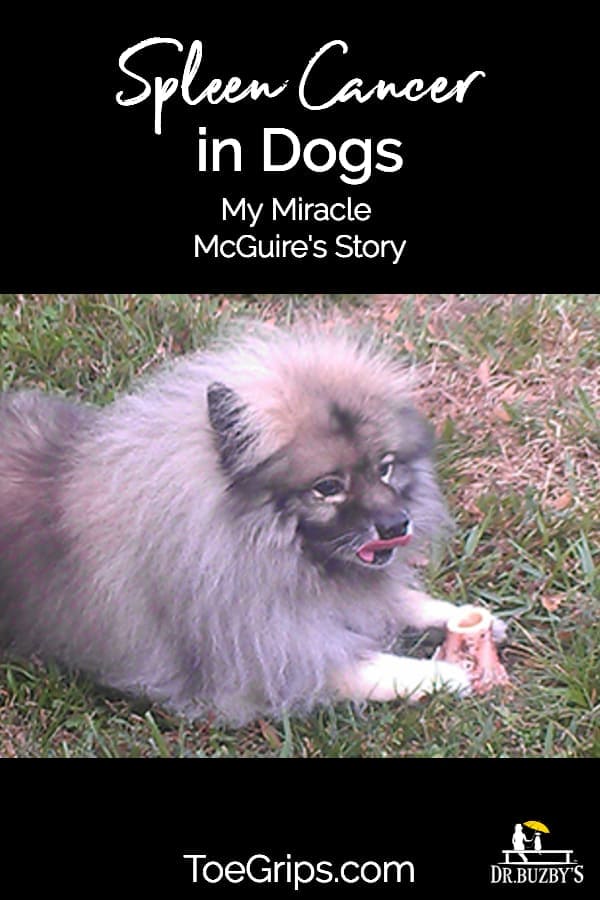
Spleen Cancer In Dogs
Chronicling My Miracle McGuire’s Story
By Carol Harris
Hard to believe, on February 20th McGuire turned 15 years old! McGuire, a keeshond, and I have been together since he was 8 weeks old. He has brought so much joy to my life. Because of him, I have learned so much and met so many interesting people.
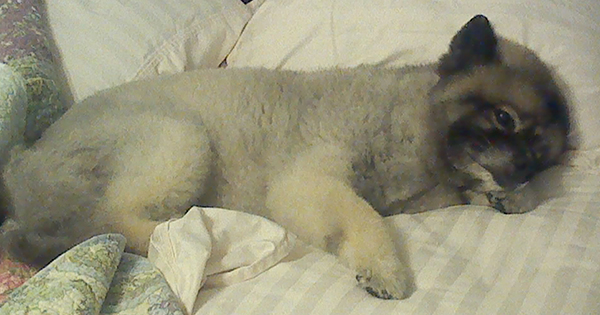 |
Spleen cancer in dogs. A diagnosis of hemangiosarcoma. Carol Harris chronicles her dog’s (her miracle McGuire’s) journey…and how losing his spleen saved his life.
Before McGuire was diagnosed with spleen cancer, I noticed unusual changes
Last summer, I noticed changes in my then 14-year-old dog, McGuire. He was standing and staring at the wall, his appetite was off, and he was panting more. We ran blood tests. His vet, Dr. DiNatale, said, “Perfect!” Perhaps it was just his age. (The average lifespan of a Keeshond is 12 to 14 years.) His appetite dwindled and one of his vets said, “Typical of an older dog.” That was part of it, but I knew it wasn’t the complete story. He was interested in food, but wouldn’t eat. Perhaps the supplements weren’t agreeing with him? We changed the food and removed the supplements—whatever it took for him to eat. It was hit or miss.
In the fall, the symptoms became more pronounced and he developed a cough. McGuire sleeps with me, so I heard him move around on the bed; sometimes he fell off. One morning he had an accident in my bedroom while I was sleeping. The urine didn’t smell “right.” He was diagnosed with a UTI. Dr. DiNatale prescribed an antibiotic and gave us exercises to improve his balance. McGuire smelled the antibiotic no matter how I tried to disguise it. Every dose was a struggle. Six days later, we returned to the vet.
The vet discovers a mass in McGuire’s abdomen
Dr. DiNatale felt his abdomen and discovered a mass. The atmosphere changed. There was a flurry of activity and questions. We needed a blood test ASAP, but the local lab had finished their pickups. Would they come back? Meanwhile, they had trouble drawing blood because McGuire couldn’t get comfortable. I left the room and waited. My mind raced, and I was filled with dread.
Mass. Abdomen. The two words could mean a diagnosis of hemangiosarcoma
Mass. Abdomen. I had heard those words frequently in the past year. Frequently, the diagnosis was hemangiosarcoma (HSA). HSA is a rapidly growing, highly invasive cancer that may attach to the spleen. It often remains undetected until the dog begins hemorrhaging internally and collapses. By then, the hemangiosarcoma has often metastasized to the liver or lungs.
I tried to focus on the positive. We found the mass and he hadn’t collapsed. Dr. DiNatale has had success managing other dogs with hemangiosarcoma. I kept telling myself “Don’t freak out. It will be ok.” We treated McGuire for pain and discomfort, and talked strategy. First, get x-rays and an ultrasound. Second, get a surgical consult. Dr. DiNatale contacted the surgeon with the case specifics. Third, start McGuire on Yunnan Baiyao, a Chinese herb formula that controls bleeding.
The timing was tricky. The mass was detected on Tuesday, Dec 22, 2015. Yes, right before Christmas. Ugh!
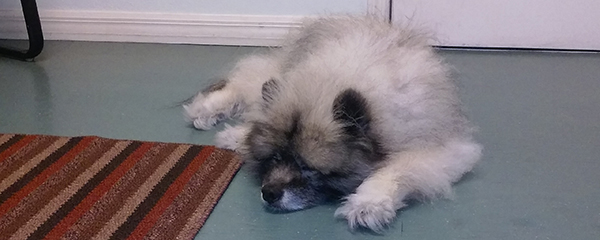 |
Taking the good with the bad
The next day I was able to get x-rays. Good news: no spots on his lungs or liver. Bad news: they couldn’t detect the tumor’s origin from the ultrasound. Also, McGuire had a grade four heart murmur. The surgeon was unavailable and the vet felt McGuire was a poor surgical candidate. She recommended the local specialty clinic, but was pessimistic. I was discouraged. The choices were bleak.
We returned to Dr. DiNatale’s office. One look on my face said it all—I wouldn’t let him suffer. Dr. DiNatale saved his life a second time by restating the facts.
• We had not seen the surgeon, who is very talented and comfortable with difficult cases. She had previously removed difficult masses for Dr. DiNatale.
• According to his blood work, he was NOT anemic, which meant he probably wasn’t bleeding internally.
• Even if surgery was not an option, there were ways to manage the mass using Chinese herbs and diet.
On Christmas Eve, I contacted the surgeon. She knew McGuire because she had performed surgery on him the year before. She had the notes from Dr. DiNatale, and said exploratory surgery was possible and that she was comfortable with giving him anesthesia. Monday would be crazy, so I suggested Tuesday, Dec 29th—five days away.
Countdown to surgery and McGuire’s continued decline
It was a LONG five days. Over the weekend, McGuire seemed to have more problems. He had trouble walking, more difficulty getting comfortable and started resting his head on my leg or shoulder, which was very unnatural for him.
Tuesday, December 29th. McGuire and I headed down to the surgeon’s office. I had a long talk with him on the way. I reviewed our life together, all the activities we participated in, the people we met, the places we had been together, and how lucky I was that he chose me. I told him how much I loved him and listed all the other people that loved him. That was the easy discussion. The next part was harder. If McGuire was tired and ready to go to the bridge, I understood. He could go with my blessing.
Would this be our last good-bye?
We made it to the surgeon’s office. McGuire walked in from the parking lot, but it was an effort. He made it to the scale in the reception area, but couldn’t walk to the treatment room. The vet tech offered to pick him up, I refused. It was my honor and privilege to carry him. For all I knew, it might be the last time. I repeated “our” poem while I handed him off to the vet tech for surgery:
I love you more than all the bones in China...All the fish in the sea...All the stars up in the sky... And all the sand upon the beach...Click To Tweet
One final “I love you, Little Man” and the vet tech disappeared with him behind the door to the surgical area.
Surgery. Splenectomy. Streams of tears.
I stayed in the reception area for the next two to three hours. Working puzzles on my iPad, texting friends, talking to other dog owners, anything to keep me busy while I waited. McGuire was first on the surgical schedule. The surgical vet tech came out 45 minutes after surgery started: the mass was attached to the spleen, they would do a splenectomy. That was good news—if it had been attached to a lymph node or intestine, nothing could be done. Tears of relief streamed down my face and the receptionist handed me a box of tissues. About 30 minutes later, the surgeon walked out—all smiles. McGuire was in recovery and doing well after the splenectomy. I surprised her (and myself!) with a big hug! Thirty minutes later, I was sitting in recovery with my loyal, loving canine companion.
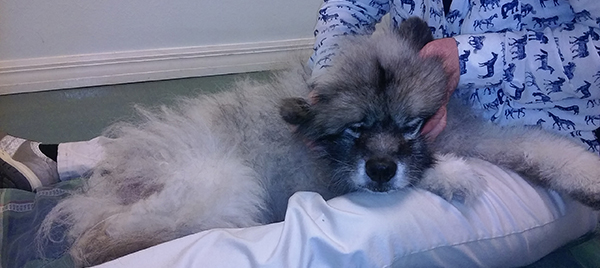 |
McGuire’s touch-and-go recovery following removal of his spleen
I was overjoyed! I reunited with McGuire who was underneath a blanket and out of it. He woke a little as I sat next to him gently stroking his fur, talking to him, and reassuring him. The surgeon showed me his spleen and the mass. No wonder he couldn’t get comfortable! After a while, I left him and headed back to Dr. DiNatale’s office to share the good news.
When I arrived at the office, the receptionist, vet tech, purchasing manager, and Dr. DiNatale were all in the reception area. I shared the good news. Their faces showed guarded relief. Dr DiNatale said she wanted to see McGuire the next day for fluids.
Before he came home that night, the surgeon’s team gave him a shot for pain. The ride home was uneventful and quiet. He slept most of the night. Before bedtime, I gave him the pain killer and Yunnan Baiyao for bleeding. The next morning, I discovered he had spit out the pain killer (Tramadol) and one of the Yunnan Baiyao capsules. He vigorously fought all the medications: Yunnan Baiyao, Tramadol, and the antibiotic. I was concerned he would rip out a staple or tear the internal stitches as he struggled.
Pain and post-surgical complications
We made our way to Dr. DiNatale’s office. McGuire would not lie down in the car. He was panting heavily and had a glazed look in his eyes. I had to carry him inside. The receptionist commented about how much pain he was in and quickly escorted us into a room. Within five minutes, Dr. DiNatale and the vet tech arrived. It was obvious the situation was serious. They asked about the pain killer, and I explained that he had spit it out. He was experiencing post-surgical complications: dehydration, uncontrolled pain, and fever. They gave him fluids and we discussed pain management. The fluids worked magic. McGuire was much perkier and was able to walk into the house. The next four days would be critical.
The pathology report: The mass was malignant hemanigiosarcoma
The next few days consisted of taking his temperature several times a day, administering medications, and getting him to eat. On Monday, January 4th, the surgeon called with the pathology report. Bad news: It was malignant hemangiosarcoma and a secondary condition called disseminated intravascular coagulation (DIC). DIC is a life-threatening condition in which the blood clots throughout the body and internal/external bleeding can occur. We were lucky—removing the mass resolved the DIC, and there was no sign of hemangiosarcoma in his liver.
My Miracle, McGuire: overcoming post-surgical complications
His staples were removed two weeks after surgery, and he was given a clean bill of health. Dr. DiNatale performed a chiropractic adjustment and acupuncture, and we celebrated his life. He overcame significant complications and survived!
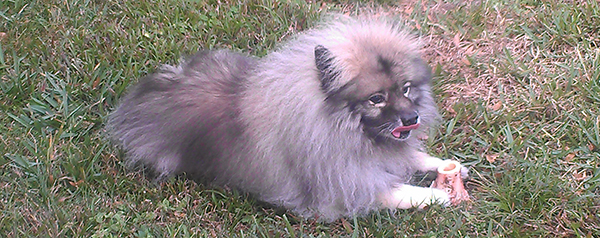 |
McGuire’s pack of caring friends and family
Many people contributed to McGuire’s journey. I affectionately refer to them as “Team McGuire.” They included family, friends, and Dr. DiNatale and her staff. McGuire had a cheering section that prayed for his recovery or sent him healing love and light.
Every moment with McGuire is a celebration!
Since surgery, we have been asked, “How much more time did the surgery buy you?” I don’t know; there wasn’t an expiration date stamped on his foot after surgery. It is counterproductive and depressing to focus on this. Instead, McGuire and I have adopted the philosophy:
“Every day is a gift! Celebrate today!”Click To TweetA touching note and update from Carol, McGuire’s dog mom…
My miracle McGuire left his paw prints on so many.
It is hard to believe it’s been two years since I wrote this blog post. It’s even harder to believe it’s been a year since McG took flight on March 9. It is bittersweet…my wonderful little man. He left his paw prints on many – through his experience with ToeGrips and HSA. I am convinced he was a teaching soul. – Carol


My dog is 16 with a grade 3 heart murmur. But she’s a fighter. We just found out about the mass two days ago while doing an ultrasound on her heart. Should I do the surgery? My vet says it a 50/50 chance for her to survive the surgery.
Hi LukSuk,
So sorry to hear that your dear senior dog has a splenic mass. The decision of whether or not to do surgery is a difficult one, especially in a senior dog with concurrent heart issues. Without seeing the ultrasound and examining your dog, I don’t have enough information to help you make a decision. But whatever you decide and whatever the outcome, remember that you made the decision you thought was best with the information you had. Your dog knows you love her and are doing the things you think are best for her.
In case they are helpful, here are a few other articles about splenic tumors:
1) Hemangiosarcoma in Dogs: Symptoms, Treatment, and Life Expectancy
2) Splenic Masses in Dogs: Types, Diagnosis, Treatment, and Prognosis
3) When To Euthanize A Dog With Hemangiosarcoma: A Vet’s Guidance
Can i have the name and number of the vet that operated on your dog? We discovered a mass in our dog through scans and his vet said it’s a splenic mass. I want to fight for my dog, but I don’t know who to trust to do this surgery. My dog has been good so far, he is scheduled for a surgery at a emergency vet on the 3rd but i don’t know if i can trust them they were just referrals from his vet.. which they were given several. The conversation i had with the vet at this place was really pushing for euthanasia without even giving me hope of treating my dog. They only contacted their only surgeon after i said that I didn’t care about the negative side until i fought tooth and nail to give my pup a fighting chance. He is eating, drinking, going potty, wagging his tail, sometimes even “jogging” we found this huge mass two weeks ago and he is still here waiting for this surgery. I need to find a good surgeon. I came across this page by accident i was just browsing about the mass and found you..
Hi Karlla,
I am so sorry your dog has received this devastating diagnosis. Unfortunately, I do not have contact information for the surgeon in this article as this was written by a different author, Carol Harris, back in 2016. Any surgery specialist should be able to perform the splenectomy and I would not think your vet would offer a referral to a vet they did not trust. I understand your hesitation after hearing the surgeon’s recommendation for euthanasia. They are just trying to give you their best advice and offering their expert opinion. You can still go forward with the surgery if you feel that is the best choice for your pup. I will attach links to more recent articles with more information and great advice from other readers. Praying for a positive outcome for your sweet boy. Feel free to leave an update if you have a chance.
1. Splenic Masses in Dogs: Types, Diagnosis, Treatment, and Prognosis
2. Hemangiosarcoma in Dogs: Symptoms, Treatment, and Life Expectancy
3. Enlarged Spleen in Dogs: 7 Causes
4. When To Euthanize A Dog With Hemangiosarcoma: A Vet’s Guidance
Hi Carol…. Your story is sooo beautiful… what an amazing doggie Mom you are… McG was a lucky pup… my husky, Tasha, has hemangiosarcoma, her spleen. Was removed on May 18, a little over a month ago… I have been giving her Yunnan also … and she has been doing good, but today she is panting, restless,, not wanting to eat… I am really nervous, taking her to vet in an hour, not anticipating good news, but she needs help… please pray for her!! ???. Lovingly, Carolyn
Hi Carolyn,
So sorry to hear about your pup Tasha’s hemangiosarcoma diagnosis and decline today. It sounds like you are making the right choice to bring her to the vet for an examination. Sending love and strength to deal with whatever that visit may hold for you both.❤
my doghas spleen cancer her veterinary Dr said their nothing that can be done but I know that God is good plaese can one heal me
Hello Val, Please start by checking out this hopeful information from veterinary oncologist, Dr. Sue Ettinger:
https://drsuecancervet.com/are-splenic-masses-in-dogs-always-hermangiosarcoma-vlog-84/ ♥️
Hello! Thanks for sharing. I’m having trouble making the decision on going through with the surgery! Marlo is my pitt/lab, going on 13 but In really good health with a soft murmur! What do I do? ?
Hello Julie, I would absolutely recommend following your vet’s advice, whatever that may be, but if it’s a surgery for a splenic mass, I would do that surgery for my own dog for sure. It’s much better to remove the spleen as a non-emergency surgery than as an emergency surgery in a life-threatening crisis.
So giving my dog tramadol and yanna. Bayou is safe? My dog is passed having surgery. I just want him to be as comfortable as possible until it gets too much.
Hello Dottie,
I’m sorry that you and your dog are in this situation. I know it’s heartbreaking. Certainly keep in close contact with your veterinarian for recommendations, but I would consider Tramadol and Yunnan Baiyao safe together, and wise.
Carol, you take such amazing care of the little man. He is lucky to have chosen you. Good job team McGuire!!!
Thank you Susan…. He takes good care of me, too.
Beautiful story! It’s reading something that gives you hope!
Cyndi,
Thank you… Yes, there is hope!
In the past week, we have:
Had a physical exam – Vets say they can’t feel any abnormalities or enlargement of his liver.
Ran blood panels – all blood chemistries are looking good.
X-rays and ultra sound – liver, lungs and stomach are clear.
We are celebrating!